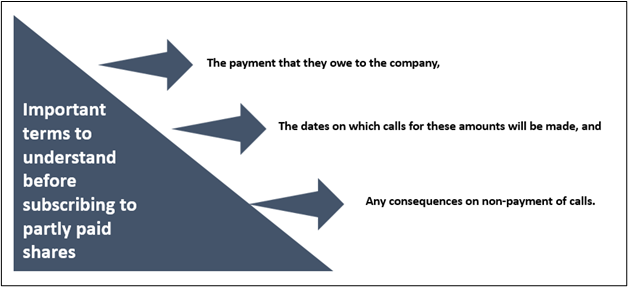Definition
Related Definitions
Partly Paid Shares
What are partly paid shares?
Once a company raises capital from shareholders, it issues shares as a part of the capital to them. Shares represent the stake they have in the corporation. Now, these shares are either fully or partly paid. For a fully paid share, the company collects the entire share value at once, at the time of the share issue. However, in partly paid shares, the company collects money in installments, one of which is at the time of issue. In partly paid shares, the company raising capital fixes a timeline for collecting the remaining parts of the share price. Companies that do not want the entire capital in one go issue partly paid shares. Partly paid shares also give time to shareholders for payment on their shares.
Summary
- Partly paid shares represent a stake in the company, although the issuing company collects money in installments on such shares.
- Partly paid shares are an efficient way to acquire shares in a company without an upfront large capital payment.
- Holders of partly paid shares need to have an understanding of their rights on shares.
Frequently Asked Questions (FAQ)
Where are partly paid shares listed?
Partly paid shares, just like their counterparts, fully paid shares, are listed on a stock exchange. Therefore, they are available for buying and selling on the exchange. However, the price depends on the issuing company's fully paid share price and the value of payments made until now.
Using partly paid shares, investors can tap on an opportunity to buy a company's shares at a lower price than its fully paid stock. First, however, they need to pay the remaining instalments on a pre-decided due date or if they exit before the due date. Then, when the shares become fully paid, which means once all the installments get paid, conversion happens and partly paid shares trade at the same price.

Source: © Bizipix | Megapixl.com
Example of partly paid shares-
Consider a company XYZ Ltd issues its shares at $10 per share. Now, Maximus pays $40 in total for four shares bought. So, XYZ will issue Maximus four fully paid shares. However, Minimus, another interested investor, only pays $20 in total for four shares (i.e. $5 per share), so XYZ issues Minimus four 'partly paid' shares in return. So now, when XYZ ltd., in its register of members, will record Maximus's shares as 'fully paid' and Minimus's shares are shown as 'partly paid'. As a result, it will be registered with the depositories in the same way.
Usually, a company will only issue partly paid shares to a shareholder if they are commercially viable. For example, partly paid shares may be issued to strategic partners who cannot pay for all the shares on the issue date. The remaining payment may collect on later dates as per schedule.
How are calls made on partly paid shares?
The share issuing company usually fixes a payment schedule for partly paid shares. A shareholder who holds partly paid shares is required to pay for the calls on request by the company. The calls on the partly paid shares are made in accordance with terms on which the shares were issued, i.e., on a pre-decided date. Companies often decide an amount to be called on issued partly paid shares, per call, such as $2 per call.
The issuing company generally makes rules on partly paid shares, which are commonly contained in a company's constitution and the shareholders' agreement. Calls are made only after prior notice to the shareholders. The notice sets out the amount payable on call and the date for payment to be made. If the payment obligations do not comply with, it leads to forfeiture of the partly paid shares.
Responsibility of a shareholder holding partly paid shares-
- Payment on calls is the responsibility of the shareholders.
- The issuing company will develop all terms on partly paid shares for installments to be paid; the shareholders agree to these at time of issuing the partly paid shares.

Source: © Embe2006 | Megapixl.com
Rights on the company on partly paid shares issued-
- Issuing company can demand interest on the remaining amount as per agreed terms.
- The company can also forfeit shares if payment obligations are not adhered to.
What rights do shareholders have on partly paid shares?
Holders of partly paid shares have the same rights as shareholders having fully paid shares, including the right to-
- Receive dividend payments,
- Voting rights at the shareholders' meetings, and
- A chance to participate in the winding-up process of the company.
However, holders of partly paid shares have a right to proportional dividend payments. The proportion is typically in accordance with payments made to date on shares.
At a shareholders' meeting, the holders of partly paid shares will have the same votes as those with fully paid shares under the same class of shares issued. It means all shareholders of ordinary shares will have one vote per share, whether holding fully paid or partly paid shares.
Both company and shareholders must correctly record whether shareholders have made all payments on their shares.

Source: Copyright © 2021 Kalkine Media Pty. Ltd
How are partly paid shares defined on ASX?
In Australia, partly paid shares are also called contributing shares. Partly paid shares on ASX have a five-letter code consisting of the company code and a two-letter suffix, often CA or CZ. So, one can easily identify partly paid shares on ASX.
As per ASX website, these shares are issued without the company asking for the full issue price. The issuing company is allowed to ask for reminder payments at pre-specified future dates. Shareholders at the time of the call are legally obliged to pay for the call.
Retail investors on ASX need to sign a client agreement with brokers before trading in partly paid shares. The purpose of the client agreement is to acknowledge understanding of the risks involved in trading with partly paid shares.
